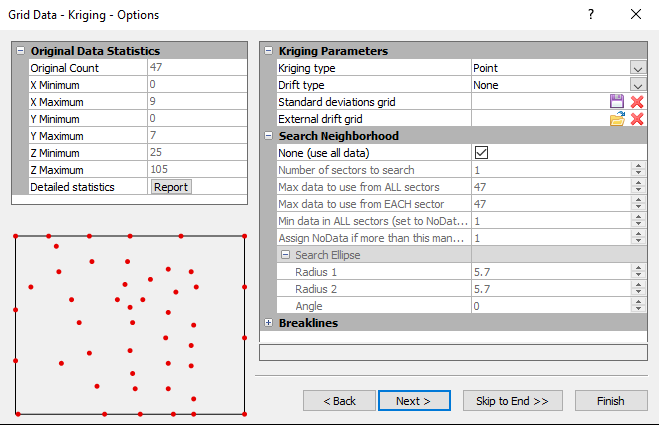Grid Data - Options
Advanced gridding options can be specified in the Grid Data dialog Options page. The Options page is displayed after the Select Data page for most gridding methods and after the Variogram page for Kriging and Cokriging methods.
|
|
|
The Grid Data Kriging Options dialog includes data statistics, a post map, and a search ellipse to help you determine which options are appropriate for your data. |
Data Statistics
The Data Statistics section displays statistical information about the source data: Original Count, Count after filtering, X Minimum, X Maximum, Y Minimum, Y Maximum, Z Minimum, and Z Maximum. When gridding XYZC data, this section will include statistics for C Minimum and C Maximum, as well.
Data Preview
A scatterplot is displayed below the Data Statistics section. The scatterplot provides a visual reference of the source data's X and Y distribution. When search is enabled, i.e. the None (Use all data) check box is not checked, the size and shape of the search ellipse is indicated by the blue ellipse in the data preview.
Gridding Parameters
The gridding parameters are displayed on the right side of the dialog. Some parameters are specific to the selected interpolation method. The Search, Anisotropy, Breaklines, and Faults parameters are shared between some or all of the interpolation methods. The section title (e.g. Kriging Parameters) and properties are dependent on the selected interpolation method.
Method Specific Parameters
The following table lists the interpolation parameters that are specific to the selected interpolation method. Click the links in the following table for more information about the specific interpolation parameters.
|
Interpolation Method |
Parameters |
|
Kriging type, Drift type, Standard deviations grid, External drift grid |
|
|
Cokriging type, Estimation method, Standard deviations grid |
|
|
Basis function and Shape factor (R2) |
|
|
Maximum residual, Maximum iterations, Relaxation factor, Internal tension, and Boundary tension |
|
|
Power and Smooth |
|
|
Smoothing factor, Quadratic neighbors, and Weighting neighbors |
|
|
<none> |
|
|
<none> |
|
|
Surface definition, Max X order, Max Y order, Max total order, and Polynomial |
|
|
Power and Polynomial order |
|
|
<none> |
|
|
Min number of data |
|
|
Metric to interpolate |
Search
The Search Neighborhood options control which data points are considered when interpolating the grid values. See the Search topic for more information on search and the Search Neighborhood options. The Search Neighborhood options are available for the following interpolation methods: Kriging, Radial Basis Function, Inverse Distance, Modified Shepard's Method (Search Ellipse only), Nearest Neighbor (Search Ellipse only), Local Polynomial, Moving Average (Search Ellipse only), and Data Metrics.
Anisotropy
The Anisotropy options apply preferential weighting to data points in a specific direction from the interpolated grid value. See the Anisotropy topic for more information on anisotropy and the Anisotropy options. The Anisotropy options are available for the following interpolation methods: Kriging, Radial Basis Function, Minimum Curvature, Inverse Distance, Natural Neighbor, and Triangulation.
Faults
A fault is a two-dimensional ASCII text file (See Blanking File Format) defining a line acting as a barrier to information flow when performing the interpolation. When interpolating a data set, data on one side of a fault is not directly used when calculating grid values on the other side of the fault.
The following interpolation methods can include fault lines: Minimum Curvature, Inverse Distance, Nearest Neighbor, and Data Metrics. Note that Faults cannot be used when gridding XYZC data with the Inverse Distance to a Power gridding method.
Breaklines
A breakline is a three-dimensional ASCII text file (See Blanking File Format) that defines a line with X, Y, and Z values at each vertex. When the interpolation algorithm sees a breakline, it calculates the Z value of the nearest point along the breakline and uses that value in combination with nearby data points to calculate the grid value.
The following interpolation methods can include breaklines: Kriging, Radial Basis Function, Minimum Curvature, Inverse Distance, Nearest Neighbor, Local Polynomial, Moving Average, and Data Metrics. Note that Breaklines cannot be used when gridding XYZC data with the Inverse Distance to a Power gridding method.
Information Area
The information area at the bottom of the Grid Data Advanced Options dialog displays a brief explanation of the selected option.
What's Next?
If gridding XYZ data, click Next to proceed to the Cross Validation page, or click Skip to End to proceed directly to the Output page. If gridding XYZC data, click Next or Skip to End to proceed to the Output (XYZC) page. Click Finish to create the grid file.
